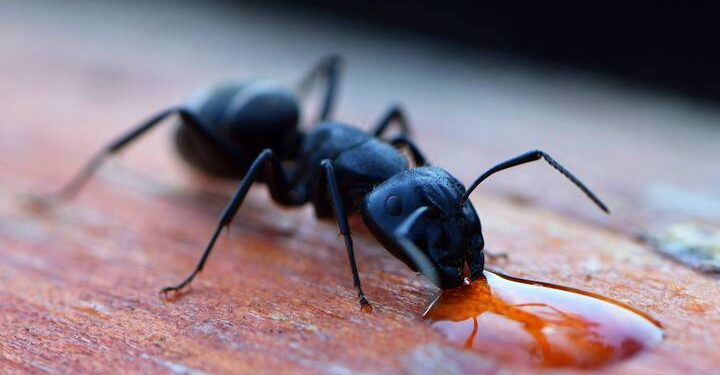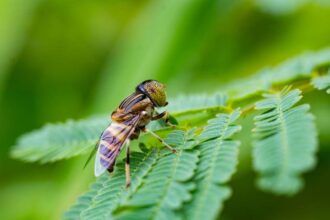10 Common Ants That Are Attracted to Water

Certain ant species possess a remarkable fondness for moisture, leading them to thrive near water sources like sinks, bathroom fixtures, and outdoor fountains. High humidity or standing water attracts these ants, creating ideal conditions for nesting and foraging. Exceptionally adept at finding and utilizing moisture, these ants might invade homes or buildings to find it.
Like many living beings, ants need water to survive. Water serves various functions within ant communities and is essential for hydration, feeding, and colony retention. Access to reliable water sources becomes vital for ants’ survival in sweltering or arid environments.
Though ants generally play vital roles in ecosystems, ants with an affinity for water can bother homeowners when they enter homes or other structures. They can spoil food, cause property damage, and present sanitation hazards. Additionally, their presence may signify deeper structural moisture issues, potentially leading to more severe problems.
Discover a list of ants that are most attracted to water.
Carpenter Ants
Carpenter ants are well-known household nuisances, famous for their large size and black or red-brown colour. They often live in wooded areas and close to water sources.
These ants rely on water to survive and gather it from sources like moist wood, building leaks, or pipe condensation. Water is essential for their colony’s hydration and softens the wood they use for nesting.
Fire Ants
Fire ants have gained a reputation due to their painful stings and aggressive nature. These tiny reddish-brown ants require water for several purposes. They need it to keep their nest’s humidity levels balanced and maintain moist conditions for their eggs and young ones.
Additionally, water keeps them hydrated and cool. In extreme heat, fire ants may build their nests near water sources like ponds or streams, ensuring easy access to this vital resource. Although they don’t consume water, it plays a crucial role in their nest upkeep and survival, so they are often spotted around watery habitats.
Argentine Ants
Argentine ants, small and ranging from light to dark brown, are famous for their massive numbers and unique trailing behaviour. Originating from South America, these ants have travelled across the globe, becoming invasive due to their expansive colonies and ability to push out native ant species.
Argentine ants are attracted to water sources, which are essential for survival. They rely on water to stay hydrated and nurture their offspring, ensuring their colony thrives and prospers. You can often spot Argentine ants near rivers, streams, or residential areas with high moisture levels, as water is vital to their habitat.
Odorous House Ants
Odorous house ants are tiny brown or black insects that release a noticeable unpleasant smell when crushed. These little pests invade homes for sweet treats. Water holds a vital role in their lives for several reasons.
Not only do they need water to dissolve and carry their food (often sugary or packed with moisture), but they also need it for hydration and keeping their nest humidity stable. Due to their inclination towards moist environments, odorous house ants often find comfort near water sources like sinks, bathrooms, and kitchens.
Pharaoh Ants
Pharaoh ants are tiny and range in colour from light yellow to reddish-brown. These ants stand out for their adaptability and intricate colony structures. Often found in homes and commercial buildings, they can be a pesky household problem.
These ants can find water sources and food by using their sharp sense of smell. You’ll typically spot them near kitchens, bathrooms, or other areas with easy water access.
Pavement Ants
Now, let’s talk about pavement ants. These tiny fellows are brown or black and live in cracks found on sidewalks, driveways, or building foundations. Pavement ants eat various foods, from sweets and proteins to other insects. Though water isn’t as vital to them as it is to other ant species, it still holds importance in their lives.
They depend on water for hydration and moisture levels inside their nests. Pavement ants hang out near puddles or leaky pipes to seize water resources. While they aren’t as drawn to water as other ants, it’s still a key part of their routines.
Bullet Ants
Bullet ants, large and mighty insects, are famous for their excruciating stings that feel like bullet shots, giving them their name. Found in South America’s rainforests, these ants are known for their tremendous strength and fierce behaviour. Bullet ants are attracted to water for several reasons. They need water for hydration, just like all living creatures.
Additionally, being near water influences their hunting habits. They often look for insects and prey close to water, using higher insect activity in wet areas. In this way, water is crucial for life and serves as an excellent place to find food.
Weaver Ants
Weaver ants are medium-sized insects recognized for their remarkable nesting abilities. They build complex nests by weaving leaves together with larval silk. These ants are adaptable and create large, well-organized colonies throughout tree branches. Water dependence might not be as prominent in weaver ants as other ant species, but its presence significantly impacts their environment.
Weaver ants gravitate towards resources such as streams or rivers to obtain the humidity necessary for their silk-weaving skills. Water softens leaves and makes them more pliable when constructing nests. As a result, weaver ants typically establish colonies near water sources, ensuring a constant supply of moisture needed for nest-building activities.
Army Ants
Army ants lead wandering lives, moving in big, orderly groups to search for food. They need water mainly to drink since all living things need water to survive. They count on finding water sources, like streams or puddles, to wet their whistles. This helps them stay lively and stick together while wandering.
Crazy Ants
Crazy ants get their name from their wild and frantic actions. These tiny ants need water to survive. Water is critical for their colony’s survival because it keeps humidity inside their nests. Crazy ants usually make their homes in damp spots, like decaying logs, piles of leaves, or dirt near where they can find water. When there’s water around, these ants can take better care of their nests, protecting their babies and eggs from drying out.


